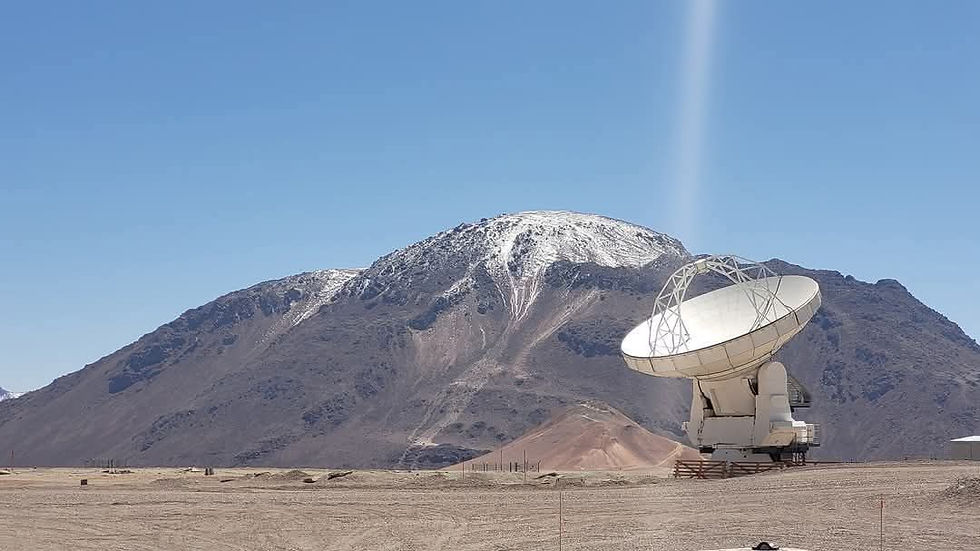On the Road Back from ALMA: A Glimpse into the Universe’s Secrets
- Abbas Mokhtarzadeh

- Aug 5
- 3 min read
Updated: Nov 10
On the Road Back from ALMA: A Glimpse into the Universe’s Secrets
December 2022

As we journeyed back from our ACEAP expedition, one stop continued to echo in our minds: the ALMA Observatory. This stunning array of radio telescopes is perched high on Chile’s Chajnantor Plateau. This site, among the highest and driest on Earth, offers ideal conditions to observe the cold and distant universe. It captures invisible signals that reveal the origins of stars, galaxies, and perhaps life itself.
APEX: A Path to the Stars
Nearby stands APEX (Atacama Pathfinder Experiment), a 12-meter single-dish submillimeter telescope located at over 5,100 meters elevation. Built using a prototype ALMA antenna, APEX observes similar wavelengths and helped pave the way for ALMA’s full array. Despite its solitary design, APEX is a scientific powerhouse in its own right. It contributes to discoveries about molecular clouds, star birth, and galactic evolution.
Learn more: APEX Telescope
The Atacama: A Natural Window into the Cosmos
The Atacama Desert, stretching across northern Chile, is Earth’s ultimate natural observatory. With its extreme dryness, high altitude, and minimal light pollution, it allows telescopes like ALMA and APEX to detect the faintest cosmic whispers. These signals are lost to moisture and interference elsewhere. These rare conditions have made the region a cornerstone of 21st-century astronomy.
ALMA at a Glance
ALMA (Atacama Large Millimeter/submillimeter Array) is the world’s most powerful radio telescope. It was built through a global collaboration among Europe, North America, East Asia, and Chile. Operating at millimeter and submillimeter wavelengths, ALMA captures a rare “rain” of invisible cosmic light. This light unlocks the mysteries of the cold universe, from star and planet formation to the earliest galaxies.
With 66 high-precision antennas spread across distances of up to 16 kilometers, ALMA functions as a single, massive telescope. It offers resolution sharper than even the Hubble Space Telescope.
Learn more: ALMA Observatory
Impact Beyond Astronomy
The discoveries made at ALMA and APEX go far beyond astronomy. Their advanced technologies contribute to breakthroughs in medical imaging, climate science, and telecommunications. These observatories also fuel international cooperation and scientific education. They inspire new generations of researchers and explorers.
A Familiar Design
The ALMA dishes—like the one pictured here—share much in common with APEX:
12-meter parabolic reflector
High surface accuracy for submillimeter precision
Alt-azimuth mount with a Cassegrain focus
APEX and ALMA stand as siblings in the high desert, each extending humanity’s vision into the invisible universe.
Cerro Chajnantor: The Shining Sentinel
Looming beside the ALMA site is Cerro Chajnantor, a prominent peak rising to 5,640 meters (18,500 feet). Its name is derived from Aymara, an Indigenous Andean language. The word "chajña" means “to appear,” “to shine,” or “to dawn.” Thus, Chajnantor may be interpreted as “the shining place” or “place of appearance.” The mountain’s prominence and visibility likely earned it this name. It is fitting for a site that captures the light of the cosmos.
On our return, we were treated to another rare sight—a remolino de polvo, a swirling dust devil twisting gracefully across the desert floor. It was seen on the left side of the radio telescope! Not a tornado, but a captivating desert phenomenon, born from the intense sun and thin air. This reminded us that even in the driest place on Earth, the atmosphere is alive with motion.
The Future of Astronomy
As we reflect on our experience at ALMA and APEX, we can only imagine the future of astronomy. The advancements in technology and international collaboration will continue to push the boundaries of our understanding. The universe holds many secrets, and with each discovery, we come closer to unraveling them.
The importance of these observatories cannot be overstated. They are not just tools for scientists; they are gateways to the cosmos. Each signal captured is a piece of the puzzle, revealing the intricate tapestry of the universe.
In conclusion, our journey back from ALMA was not just a trip; it was a glimpse into the universe's secrets. The experience left us in awe of the vastness of space and the wonders it holds. We are excited to see what the future brings for astronomy and the discoveries that await.
[#ALMAObservatory](https://www.facebook.com/hashtag/almaobservatory?__eep__=6&__cft__[0]=AZVW-YE3kcz_mcBKAjIi_amlqwu45gIWUi3gqvK3Q0eFEW9shejxi1SrJ_k9vCqTCOWs90c5SfIg7AR5twiMPTIOBhCt_TJ-gl93fkaxw24DroTbTENV3AaA6HdbqWj8KWZkVEN1j-XIYIwXx_FqBhEC&__tn__NK-R)
[#APEXTelescope](https://www.facebook.com/hashtag/apextelescope?__eep__=6&__cft__[0]=AZVW-YE3kcz_mcBKAjIi_amlqwu45gIWUi3gqvK3Q0eFEW9shejxi1SrJ_k9vCqTCOWs90c5SfIg7AR5twiMPTIOBhCt_TJ-gl93fkaxw24DroTbTENV3AaA6HdbqWj8KWZkVEN1j-XIYIwXx_FqBhEC&__tn__NK-R)
[#AtacamaDesert](https://www.facebook.com/hashtag/atacamadesert?__eep__=6&__cft__[0]=AZVW-YE3kcz_mcBKAjIi_amlqwu45gIWUi3gqvK3Q0eFEW9shejxi1SrJ_k9vCqTCOWs90c5SfIg7AR5twiMPTIOBhCt_TJ-gl93fkaxw24DroTbTENV3AaA6HdbqWj8KWZkVEN1j-XIYIwXx_FqBhEC&__tn__NK-R)
[#Chajnantor](https://www.facebook.com/hashtag/chajnantor?__eep__=6&__cft__[0]=AZVW-YE3kcz_mcBKAjIi_amlqwu45gIWUi3gqvK3Q0eFEW9shejxi1SrJ_k9vCqTCOWs90c5SfIg7AR5twiMPTIOBhCt_TJ-gl93fkaxw24DroTbTENV3AaA6HdbqWj8KWZkVEN1j-XIYIwXx_FqBhEC&__tn__NK-R)
[#ACEAP](https://www.facebook.com/hashtag/aceap?__eep__=6&__cft__[0]=AZVW-YE3kcz_mcBKAjIi_amlqwu45gIWUi3gqvK3Q0eFEW9shejxi1SrJ_k9vCqTCOWs90c5SfIg7AR5twiMPTIOBhCt_TJ-gl93fkaxw24DroTbTENV3AaA6HdbqWj8KWZkVEN1j-XIYIwXx_FqBhEC&__tn__NK-R)
[#RadioAstronomy](https://www.facebook.com/hashtag/radioastronomy?__eep__=6&__cft__[0]=AZVW-YE3kcz_mcBKAjIi_amlqwu45gIWUi3gqvK3Q0eFEW9shejxi1SrJ_k9vCqTCOWs90c5SfIg7AR5twiMPTIOBhCt_TJ-gl93fkaxw24DroTbTENV3AaA6HdbqWj8KWZkVEN1j-XIYIwXx_FqBhEC&__tn__NK-R)
[#SpaceScience](https://www.facebook.com/hashtag/spacescience?__eep__=6&__cft__[0]=AZVW-YE3kcz_mcBKAjIi_amlqwu45gIWUi3gqvK3Q0eFEW9shejxi1SrJ_k9vCqTCOWs90c5SfIg7AR5twiMPTIOBhCt_TJ-gl93fkaxw24DroTbTENV3AaA6HdbqWj8KWZkVEN1j-XIYIwXx_FqBhEC&__tn__NK-R)
[#Astronomy](https://www.facebook.com/hashtag/astronomy?__eep__=6&__cft__[0]=AZVW-YE3kcz_mcBKAjIi_amlqwu45gIWUi3gqvK3Q0eFEW9shejxi1SrJ_k9vCqTCOWs90c5SfIg7AR5twiMPTIOBhCt_TJ-gl93fkaxw24DroTbTENV3AaA6HdbqWj8KWZkVEN1j-XIYIwXx_FqBhEC&__tn__NK-R)
[#AstronomyEducation](https://www.facebook.com/hashtag/astronomyeducation?__eep__=6&__cft__[0]=AZVW-YE3kcz_mcBKAjIi_amlqwu45gIWUi3gqvK3Q0eFEW9shejxi1SrJ_k9vCqTCOWs90c5SfIg7AR5twiMPTIOBhCt_TJ-gl93fkaxw24DroTbTENV3AaA6HdbqWj8KWZkVEN1j-XIYIwXx_FqBhEC&__tn__NK-R)
[#GlobalScienceProject](https://www.facebook.com/hashtag/globalscienceproject?__eep__=6&__cft__[0]=AZVW-YE3kcz_mcBKAjIi_amlqwu45gIWUi3gqvK3Q0eFEW9shejxi1SrJ_k9vCqTCOWs90c5SfIg7AR5twiMPTIOBhCt_TJ-gl93fkaxw24DroTbTENV3AaA6HdbqWj8KWZkVEN1j-XIYIwXx_FqBhEC&__tn__NK-R)
[#GlobalCollaboration](https://www.facebook.com/hashtag/globalcollaboration?__eep__=6&__cft__[0]=AZVW-YE3kcz_mcBKAjIi_amlqwu45gIWUi3gqvK3Q0eFEW9shejxi1SrJ_k9vCqTCOWs90c5SfIg7AR5twiMPTIOBhCt_TJ-gl93fkaxw24DroTbTENV3AaA6HdbqWj8KWZkVEN1j-XIYIwXx_FqBhEC&__tn__NK-R)
[#CitizenScience](https://www.facebook.com/hashtag/citizenscience?__eep__=6&__cft__[0]=AZVW-YE3kcz_mcBKAjIi_amlqwu45gIWUi3gqvK3Q0eFEW9shejxi1SrJ_k9vCqTCOWs90c5SfIg7AR5twiMPTIOBhCt_TJ-gl93fkaxw24DroTbTENV3AaA6HdbqWj8KWZkVEN1j-XIYIwXx_FqBhEC&__tn__NK-R)
[#RemolinoDePolvo](https://www.facebook.com/hashtag/remolinodepolvo?__eep__=6&__cft__[0]=AZVW-YE3kcz_mcBKAjIi_amlqwu45gIWUi3gqvK3Q0eFEW9shejxi1SrJ_k9vCqTCOWs90c5SfIg7AR5twiMPTIOBhCt_TJ-gl93fkaxw24DroTbTENV3AaA6HdbqWj8KWZkVEN1j-XIYIwXx_FqBhEC&__tn__NK-R)
[#DustDevil](https://www.facebook.com/hashtag/dustdevil?__eep__=6&__cft__[0]=AZVW-YE3kcz_mcBKAjIi_amlqwu45gIWUi3gqvK3Q0eFEW9shejxi1SrJ_k9vCqTCOWs90c5SfIg7AR5twiMPTIOBhCt_TJ-gl93fkaxw24DroTbTENV3AaA6HdbqWj8KWZkVEN1j-XIYIwXx_FqBhEC&__tn__NK-R)
[#ESO](https://www.facebook.com/hashtag/eso?__eep__=6&__cft__[0]=AZVW-YE3kcz_mcBKAjIi_amlqwu45gIWUi3gqvK3Q0eFEW9shejxi1SrJ_k9vCqTCOWs90c5SfIg7AR5twiMPTIOBhCt_TJ-gl93fkaxw24DroTbTENV3AaA6HdbqWj8KWZkVEN1j-XIYIwXx_FqBhEC&__tn__NK-R)
[#NSF](https://www.facebook.com/hashtag/nsf?__eep__=6&__cft__[0]=AZVW-YE3kcz_mcBKAjIi_amlqwu45gIWUi3gqvK3Q0eFEW9shejxi1SrJ_k9vCqTCOWs90c5SfIg7AR5twiMPTIOBhCt_TJ-gl93fkaxw24DroTbTENV3AaA6HdbqWj8KWZkVEN1j-XIYIwXx_FqBhEC&__tn__NK-R)
[#NRAO](https://www.facebook.com/hashtag/nrao?__eep__=6&__cft__[0]=AZVW-YE3kcz_mcBKAjIi_amlqwu45gIWUi3gqvK3Q0eFEW9shejxi1SrJ_k9vCqTCOWs90c5SfIg7AR5twiMPTIOBhCt_TJ-gl93fkaxw24DroTbTENV3AaA6HdbqWj8KWZkVEN1j-XIYIwXx_FqBhEC&__tn__NK-R)
[#AUI](https://www.facebook.com/hashtag/aui?__eep__=6&__cft__[0]=AZVW-YE3kcz_mcBKAjIi_amlqwu45gIWUi3gqvK3Q0eFEW9shejxi1SrJ_k9vCqTCOWs90c5SfIg7AR5twiMPTIOBhCt_TJ-gl93fkaxw24DroTbTENV3AaA6HdbqWj8KWZkVEN1j-XIYIwXx_FqBhEC&__tn__NK-R)
[#NAOJ](https://www.facebook.com/hashtag/naoj?__eep__=6&__cft__[0]=AZVW-YE3kcz_mcBKAjIi_amlqwu45gIWUi3gqvK3Q0eFEW9shejxi1SrJ_k9vCqTCOWs90c5SfIg7AR5twiMPTIOBhCt_TJ-gl93fkaxw24DroTbTENV3AaA6HdbqWj8KWZkVEN1j-XIYIwXx_FqBhEC&__tn__NK-R)
[#NASA](https://www.facebook.com/hashtag/nasa?__eep__=6&__cft__[0]=AZVW-YE3kcz_mcBKAjIi_amlqwu45gIWUi3gqvK3Q0eFEW9shejxi1SrJ_k9vCqTCOWs90c5SfIg7AR5twiMPTIOBhCt_TJ-gl93fkaxw24DroTbTENV3AaA6HdbqWj8KWZkVEN1j-XIYIwXx_FqBhEC&__tn__NK-R)
[#ESA](https://www.facebook.com/hashtag/esa?__eep__=6&__cft__[0]=AZVW-YE3kcz_mcBKAjIi_amlqwu45gIWUi3gqvK3Q0eFEW9shejxi1SrJ_k9vCqTCOWs90c5SfIg7AR5twiMPTIOBhCt_TJ-gl93fkaxw24DroTbTENV3AaA6HdbqWj8KWZkVEN1j-XIYIwXx_FqBhEC&__tn__NK-R)



Comments